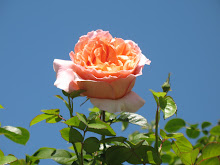Early this past spring, I purchased three containers of a cool looking plant at M&M Nursery, ptilotus, or Wallaby Tail, as they were labeled. I soon learned that quite a buzz was building within the western gardening community regarding this native Australian species, now finding its way into our local nurseries.
Well, several months later, I'd have to say I'm not too impressed - either that or these ptilotus (ptiloti?) are none too impressed with my gardening skills. My ptilotus looked great up until mid-June, then as you can see from the photo they all started pooping out, as this one, like a spent annual. The plant is advertised as being very drought tolerant, and mine are positioned near other drought tolerant plants that continuously thrive. I did a little
research, and found that there are several varieties of ptilotus, and I'm thinking that the three I purchased were mis-labeled and may actually be the Joey variety, which is indeed an annual, not the perennial Wallaby Tail or Platinum Wallaby.

Regardless, why would they all start to die-off in mid-summer if they were annuals? It would make more sense if they croaked as the weather chilled. There's the issue of alkaline versus acidic soil tolerance, as discussed by Sunset, between the two varieties - I honestly don't know the makeup of my soil. However, I did see several specimens at Roger's Gardens a couple weeks ago that looked great, with bright green, rubbery foliage and leaves at least double the size of mine - possibly these were truly the preferable Platinum Wallaby sub-species.
Anyways, my current thoughts are that I'll probably abandon efforts to cultivate the popular ptilotus in the future, unless anyone has any suggestions as to what I may be doing wrong.











